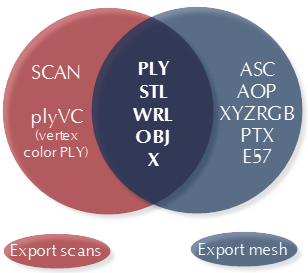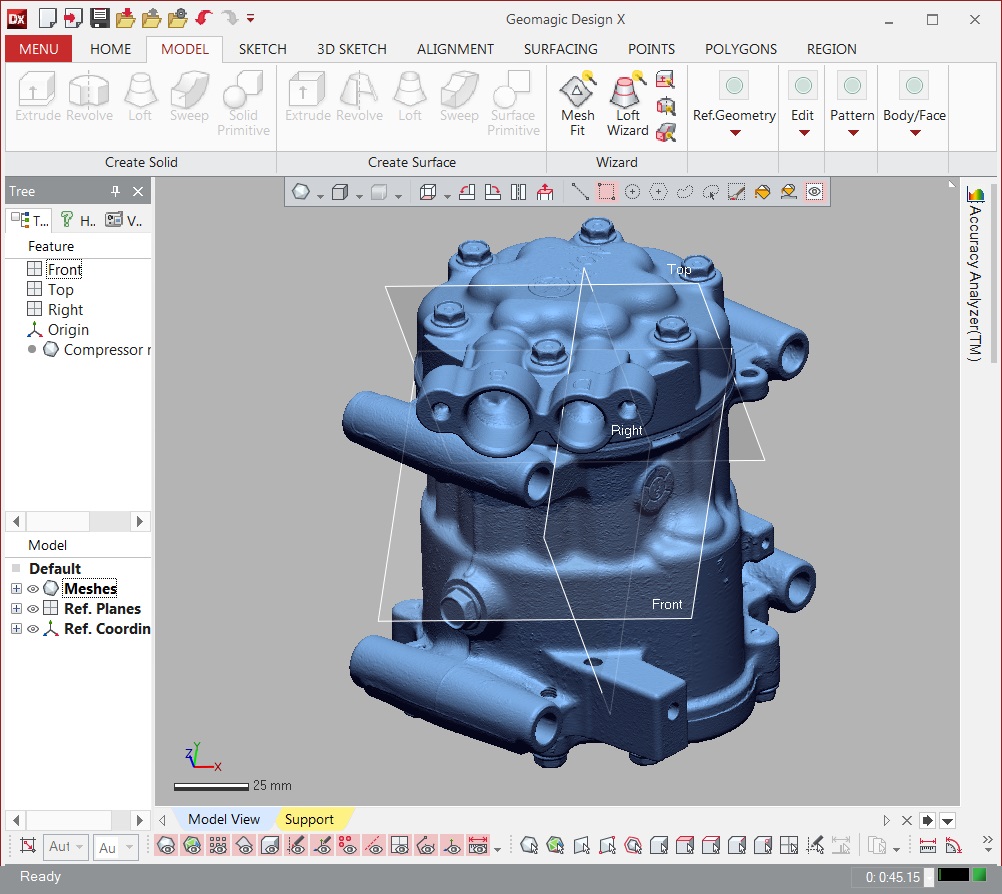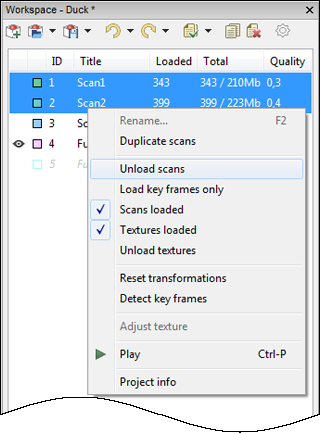Project Operations¶
A project encompasses all 3D data obtained by scanning and postprocessing that can be saved to disk and accessed for later use. In addition, it contains measurement results (see Measurement Tools). For each project, a corresponding folder contains all project data as well as a project file describing the structure of that data.
Creating a Project¶
We recommend creating and naming a project before you start scanning (see Scanning Procedure). You can create a new project using the File → New project menu option. Click the  button at the top of the Workspace panel, or use the shortcut
button at the top of the Workspace panel, or use the shortcut Ctrl + N. Then, in the subsequent dialog (see Figure 66.), enter the project name and specify the path for the folder to which you want to save your project. While you’re working with a given project, the header of Workspace window will display its name.
Creating a project is unnecessary if you don’t plan to process or otherwise use the scanned material in a future session.
Saving a Project¶
You can save your project using the File → Save project menu option, by clicking  at the top of the Workspace panel or by hitting
at the top of the Workspace panel or by hitting Ctrl + S. For unsaved projects, a project-creation dialog will appear (see Creating a Project).
Artec Studio saves data incrementally, meaning that if you save an existing project, the application will only save newly changed or added data.
Opening a Project¶
To open an existing project, use the File → Open project menu option, click  at the top of the Workspace panel or hit
at the top of the Workspace panel or hit Ctrl + O.
Note
Files from Artec Studio versions 8, 9, 10 and 11 are mutually compatible. Earlier versions, however, may be unable to open projects saved in a later version using the SPROJ format.
By default, when you open a project, the application will restore it to the state in which it was last saved (the three scan-loading states include loaded, unloaded and key frames only—see Selectively Loading Project Data). To load faster by opening the project without loading any scans, use the Open project (scans not loaded) dropdown menu option under the  button. Alternatively, use the same option from the File menu or hit
button. Alternatively, use the same option from the File menu or hit Ctrl + Shift + O.
Note
When Artec Studio opens a project, it will determine the amount of available memory. If the scan you are trying to load requires more memory than is available in your system, the application will process it as an “unloaded” scan.
Exporting Models and Scans¶
When you want to store data for future processing, the best approach is to save the project as an SPROJ file or to export the data to the SCAN format. Any Artec Studio version can open the latter format. If you plan to use the data in other applications, however, you should save scans and individual frames in another format.
You may also need to perform one of the following tasks:
- Export one or more scans.
- Select the Export scans... command. Doing so will save all frames to folders with names that match the corresponding scan names. An exception is the
SCANformat; in this case, Artec Studio not only stores the frame-by-frame scan structure, but it does so in a single file. - Export a single surface.
- The best approach here is to select the Export meshes... command. If you marked several scans, models or frames using the
 button, Artec Studio will suggest merging them.
button, Artec Studio will suggest merging them.
Exporting Scans¶
To export scans:
- Mark any scans you want to export using the
 button.
button. - Select the Export scans... command in the File menu or the corresponding dropdown menu option using
 in the Workspace panel.
in the Workspace panel. - Click the ... button to open and specify the destination folder.
- Select Scan export format using the eponymous dropdown list (see Figure 67.).
- If the selected format supports textures, also specify the texture format.
- Select the Apply transformation checkbox, or leave it cleared (for more information, consult Understanding How Artec Studio Applies Transformations).
- Click OK.
Exporting Meshes¶
To export a mesh:
- Mark one or more models using
 or select frames in the scan by clicking on them while holding the
or select frames in the scan by clicking on them while holding the Ctrlkey. - Select the Export meshes... command in the File menu or select the corresponding dropdown menu option by clicking the triangle near the
 button in the Workspace panel.
button in the Workspace panel. - Click the ... button in the current window.
- Specify the destination folder, enter the file name, and select the appropriate format from the dropdown list.
- Click Save.
- If required, specify the Texture export format (see Storing and Exporting Color Information).
- Click OK.
See also
Note
The export process for models and scans runs in the background, so the application will allow you to continue working with the scans. The progress indicator for the export operation will appear at the bottom of the main application window. To abort the operation, click Cancel in the bottom-right corner.
Understanding How Artec Studio Applies Transformations¶
Artec Studio offers two options for exporting surfaces:
- Store surfaces using the scanner coordinates and create
XFtext files that contain the coordinates calculated during registration. To use this approach, clear the Apply transformations checkbox. - Store surfaces that are relocated to the positions calculated during registration. In this case,
XFfiles contain no relevant data. To use this approach, select the Apply transformations checkbox.
Special Aspects of Scan Placement¶
In most cases when you’re exporting a scan to a common 3D-graphics format, you should select the Apply transformations checkbox. By doing so, you instruct third-party applications to display surfaces in the same way that Artec Studio does: that is, with the origin at the center of mass. If for some reason you need to store a scan in the scanner’s coordinate system—in other words, with surfaces located at a distance from the origin that is equal to scanner’s operating range—clear the Apply transformations checkbox.
Technically, Artec Studio saves scans in the scanner’s coordinate system, but it displays them in a user-friendly manner by placing the origin at the center of mass. The actual positions of surfaces calculated during registration are stored in text (XF) files. Therefore, when you’re importing files using Artec Studio, it makes no difference whether the checkbox was cleared when Artec Studio exported them. It does make a difference, however, for third-party applications that cannot read XF files simultaneously with 3D geometry.
Storing and Exporting Color Information¶
You can transfer color information for 3D surfaces in three ways. The most common is through a texture using a separate bitmap file (see Applying Texture). Another option is to save color information in each vertex of a mesh. The third is to assign a small textured fragment to each polygon. The two latter methods produce no texture files.
Colors stored in a vertex are blended throughout the polygon. As a result, you should avoid oversimplifying the exported mesh; otherwise, colors blended over a large face may fail to render true texture information.
| Texture stored as a bitmap | PLY, VRML (*.wrl), OBJ, X, e57 |
|---|---|
| Model file contains separate texture for each face | PTX |
| Formats that support vertex color | plyVC, XYZRGB |
When exporting texture as a bitmap image, you can select one of the following formats: PNG, BMP or JPG. PNG format provides the best quality for a given file size thanks to its lossless image compression. JPG is the most compact format.
Exporting Target Coordinates¶
If you scan while in the Targets tracking mode using only Artec scanners, you can save an OBC file containing the target coordinates. Once you finish scanning, run Global registration, then do the following:
- Use the
 button to mark any scans that you captured without having uploaded an
button to mark any scans that you captured without having uploaded an OBCfile. - Select the Export scans... command from the File menu, or select the corresponding dropdown menu option using
 in the Workspace panel.
in the Workspace panel. - Click the ... button to open and specify the destination folder.
- Select obc from the Scan export format dropdown list.
- Click OK. The
targets.obcfile will appear in the folder you specified.
For more information on the OBC file structure, consult the FAQ.
Exporting to Leios¶
Artec Studio enables you to export files to Leios by accessing the File menu if the Leios software is already installed on your computer.
- Select a model in the Workspace panel
- Open File → Export to Leios
- Then, in Leios, select millimeters as the length unit for the imported files.
Exporting to Geomagic Design X¶
Polygonal models created in Artec Studio are insufficient for most design needs. Geomagic Design X (formerly Rapidform XOR) is purpose built to create manufacturing-ready CAD models directly from meshes.
To export a model,
Exporting to SolidWorks¶
Artec Studio allows you to export models to SolidWorks by using third-party plug-ins. It supports the following plug-ins:
- Geomagic for SolidWorks
- DezignWorks for SolidWorks
Note
If you have installed both plug-ins, Artec Studio will use Geomagic for SolidWorks.
To export a model,
Importing Models and Scans¶
Importing is another way to load data into Artec Studio in place of capturing or opening a project. You can import scan files created in earlier versions of the software, as well as individual frames, in the following formats: PLY, STL, VRML, OBJ and PTX. To do so, use the File → Import... menu option, Ctrl + I or the dropdown menu option for the  button. Next, select a file for importing. You can also drag and drop a file into the main Artec Studio window, or just double click on it.
button. Next, select a file for importing. You can also drag and drop a file into the main Artec Studio window, or just double click on it.
Note
The import process runs in the background, so you can continue working with the scans you’ve already loaded. The progress indicator for the import operation will appear at the bottom of the main application window. To abort the operation, click Cancel in the bottom-right corner.
Artec Studio will import frame files as individual single-frame scans. After importing each scan, the application calculates the key frames for any scan that contains more than one surface. Also, the application will check the surfaces for defects when the appropriate setting is enabled (see Surface-Consistency Detection During Import). If it finds defects, it will show a dialog with a list of defective surfaces once the import operation is complete. You can then choose which ones should be corrected (see Figure 70.).
History of Project Changes¶
Artec Studio stores all data changes, so you can undo them later. To undo an operation, click the  button in the Workspace panel, or click
button in the Workspace panel, or click  to perform the previously undone operation. You can also use
to perform the previously undone operation. You can also use Ctrl + Z or Ctrl + Y. Use the dropdown menu buttons  or
or  , respectively, to undo or redo several operations at once.
, respectively, to undo or redo several operations at once.
When you save a project, Artec Studio stores 3D data together with the history of changes. You can select the maximum length of the history in the settings window under the Performance tab (see Command History). In addition, the Compact memory button allows you to save the history of changes on a local drive and thus free up RAM. Also, the Clear command history button clears the change history, likewise freeing up RAM, and makes the undo operation for the most recent changes unavailable. To clear the history, you can use the Edit → Clear history menu option in the main window or hit Ctrl + Alt + H.
Selectively Loading Project Data¶
When working with a large data set, you may often find it necessary to free up RAM without deleting any of the project data. To this end, Artec Studio implements a mechanism for selectively loading scans. You can move to disk any currently unused scans to free up extra RAM. If a particular algorithm later requires any of the unloaded scans, the application will automatically reload them. Frames that are not currently loaded into the memory won’t show in the 3D View window.
Any scans or frames that are completely unloaded from memory will appear in a gray italicized font in the Workspace window (see Figure 71.).
Note
Before you can change a scan’s loading status, you must save the project.
To change the loading status, select the scans in the Workspace window (using the Ctrl key), click RMB and then select one of the scan-loading options in the pop-up menu (see Figure 71.):
| Menu Command | Function | Icon Appearance |
|---|---|---|
| Unload scans | Fully unload scans from RAM |  |
| Load key frames only | Only load key frames into RAM |  |
| Load scans | Fully load scans into RAM |  |
| Load textures | Fully load texture images into RAM | — |
| Unload textures | Fully unload textures from RAM | — |
Algorithms may automatically change the loading status of project data in the following cases:
- You have selected unloaded scans for processing by clicking the
 button.
button. - Artec Studio will load these scans into memory.
- Execution of the algorithm requires large amounts of memory.
- Artec Studio will unload unused scans, frames, textures or a combination thereof.
Note
In addition to 3D data, the change history can also consume a large portion of memory. For information on how to control the history size as well as how to unload or clear it, consult History of Project Changes.
Autosaving a Project¶
A project can be saved by either the user or Artec Studio. The latter case is called autosaving. For temporary (i.e., unsaved) projects, autosaving is unavailable. The application autosaves a project in the following cases:
Before running the texturing algorithm (see Texturing)
When scanning is complete and the Backup scan data to disk option is selected (see Scanning Procedure)
When unloading scans with unsaved changes (see Selectively Loading Project Data)
When the Save project before starting algorithms setting is selected (see Autosave Options):
- Before launching algorithms from the Tools panel
- Before and after running the Global registration algorithm (Global Registration)
- Before starting Autopilot (Autopilot).





